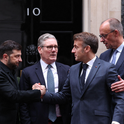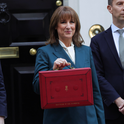For some, it began when the British Legion accepted sponsorship from BAE Systems in 2002. Or pehaps, when a poppy was painted on the side of an RAF Tornado. For others, it was the sense that the symbology was being used to silence criticism of the wars in Iraq and Afghanistan. “It has,” tweeted second world war RAF veteran Harry Lesley Smith in 2014, “been co-opted.”
For others, it’s a moved from a quiet sign of Remembrance to an icon of Brexit nationalism. The author Matt Haig tweeted, “I'm not wearing a poppy this year. I think it is shifting from a symbol remembering war's horror, to a symbol of war-hungry nationalism.”
Poppies always draw out passions, and it’s important to acknowledge that meaning is in the mind of the wearer: that someone does or doesn’t pin a piece of paper to their lapel doesn’t indicate that they sign up to everything that’s said about it. But it seems to me that there are two fascinating things about the sorts of statements I’ve quoted above.
Firstly: despite the talk of “co-opting,” red poppies have always been contentious.
They were chosen by Lady Haig—wife of the famous Field Marshall—in 1921, in a moment of vital historical context. The preceding years had seen the Irish Easter Rising, the Russian revolution and the Spanish flu pandemic. The war itself had been rife with soldier strikes, mutinies and protests, and had been ended by working-class German sailors leading a massive rebellion against their aristocratic commanders.
In 1919, there had been an attempted revolution in Glasgow and riots in England and Wales. Strikes rippled through the country. Just as the USA had struggled through its “Red Summer”, Britain had seen its “year of revolution.”
The government had organised a number of victory parades, but some of the soldiers refused to participate. When they instead held the first, more sombre Armistice Day, in 1919, a number of the veterans protested against the conditions they were expected to live in.
The poppy symbol, therefore, was chosen by the wife of perhaps the most controversial military figure in British history, at a moment when Britain’s blundering ruling class was more terrified of revolution than perhaps it had ever been. In that context, it has to be understood for what it was: a propaganda tool, functioning to silence protest by demanding national unity—the ubiquitous strategy of threatened establishments.
Lady Haig chose a poppy specifically because of a piece of rhyming propaganda for war, written by a Canadian military doctor called John Macrae, “In Flanders Field,” whose final verse is an explicit statement that refusing to continue to fight is an insult to those who have already died:
Take up our quarrel with the foe: To you from failing hands we throw The torch; be yours to hold it high. If ye break faith with us who die We shall not sleep, though poppies grow In Flanders fields.
Similarly, the poppy hasn’t just recently become a nationalist symbol. It always has been. Until this summer, there was a famous memorial on the Gallipoli peninsula in Turkey, to the Anzac soldiers who fought against the Ottoman empire there. Supposedly quoting Ataturk, the father of modern Turkey, it reads, “There is no difference between the Johnnies and the Mehmets to us where they lie side by side here in this country of ours.”
Contrast this with the Royal British Legion’s statement, published under the banner “what we remember” on their website: “The Legion advocates a specific type of Remembrance connected to the British Armed Forces, those who were killed, those who fought with them and alongside them.”
The red poppy is—and always has been—explicitly about remembering ‘our’ military dead, not all the victims of war. Not those killed in bombing raids. Not, on the whole, women. Not children. And certainly not the German, or Turkish, or Japanese, or Italian, or Afghan, or Iraqi people against whom British soldiers have fought.
It was because of all of these debates and disagreements that the Women’s Co-operative Guild finally settled on the white poppy as a new symbol of Remembrance in 1933. Unlike the red poppy, it commemorates all victims of war.
So, if this debate is as old as Remembrance itself, why do so many feel that something has changed?
First, of course, something has changed. It’s certainly the case that poppies these days are more bling than they once were, more commercial in feel (as the Twitter account @giantpoppywatch documents).
And it’s certainly the case, as Michael Gove admitted in 2014, that the government wants to use the centenary of the First World War to re-write our national story about it, to teach us that, no, this isn’t a warning against a blundering ruling class but in fact “a just war.” It’s a convenient moment to make such a case, just as the last generation which fought in it is no longer able to respond.
Why we musn’t forget the origins of the Remembrance Day poppy
The poppy hasn’t been suddenly “co-opted”—it’s always been partially about class and empire
November 10, 2017

Poppies adorn Big Ben at the Houses of Parliament. Photo: PA











